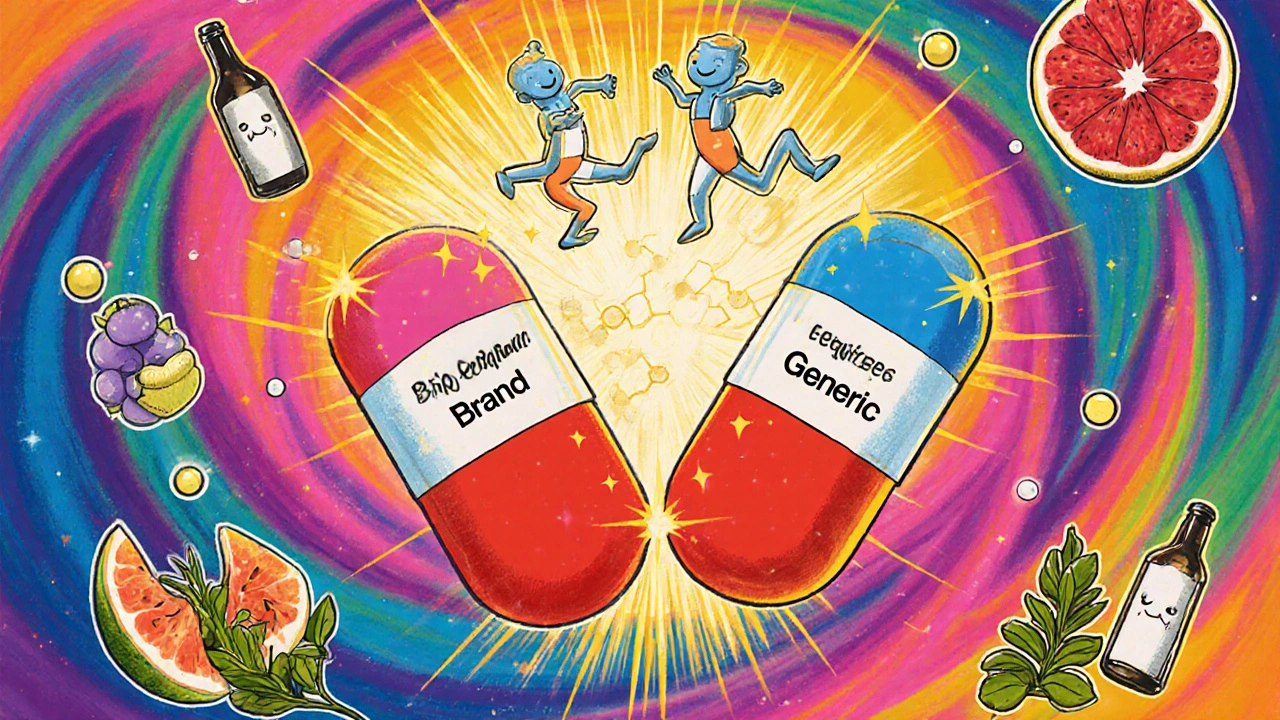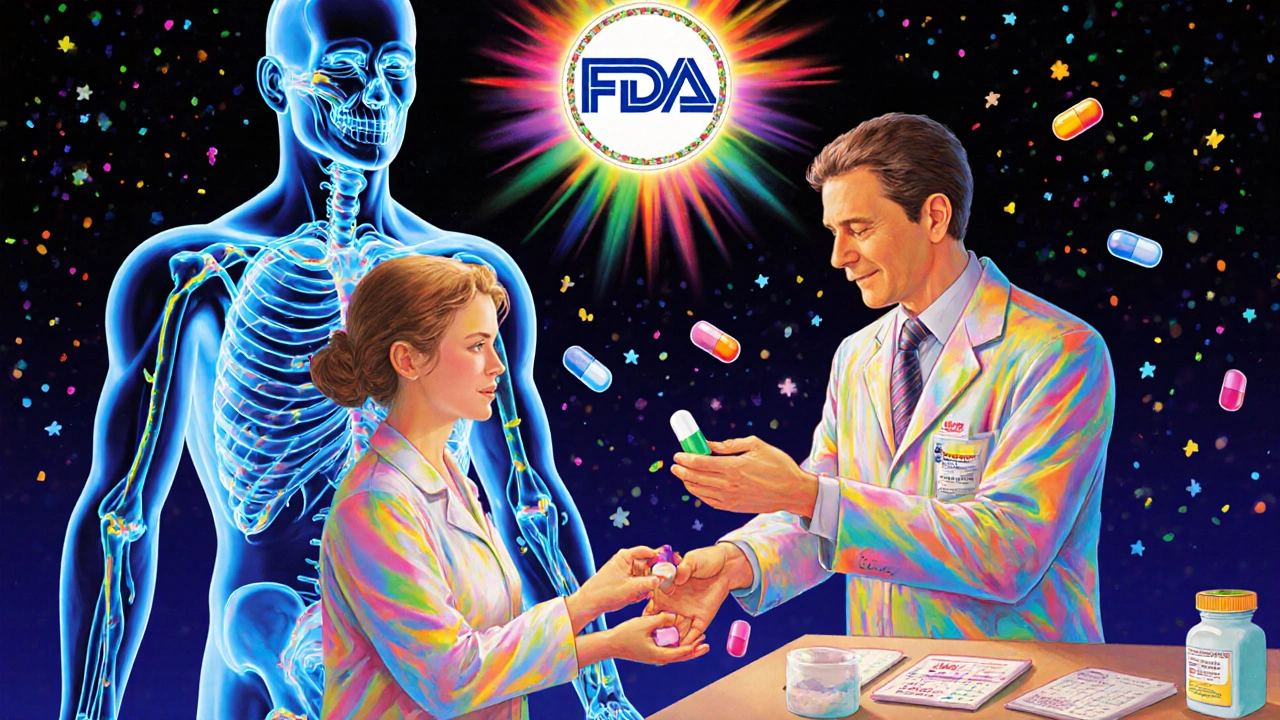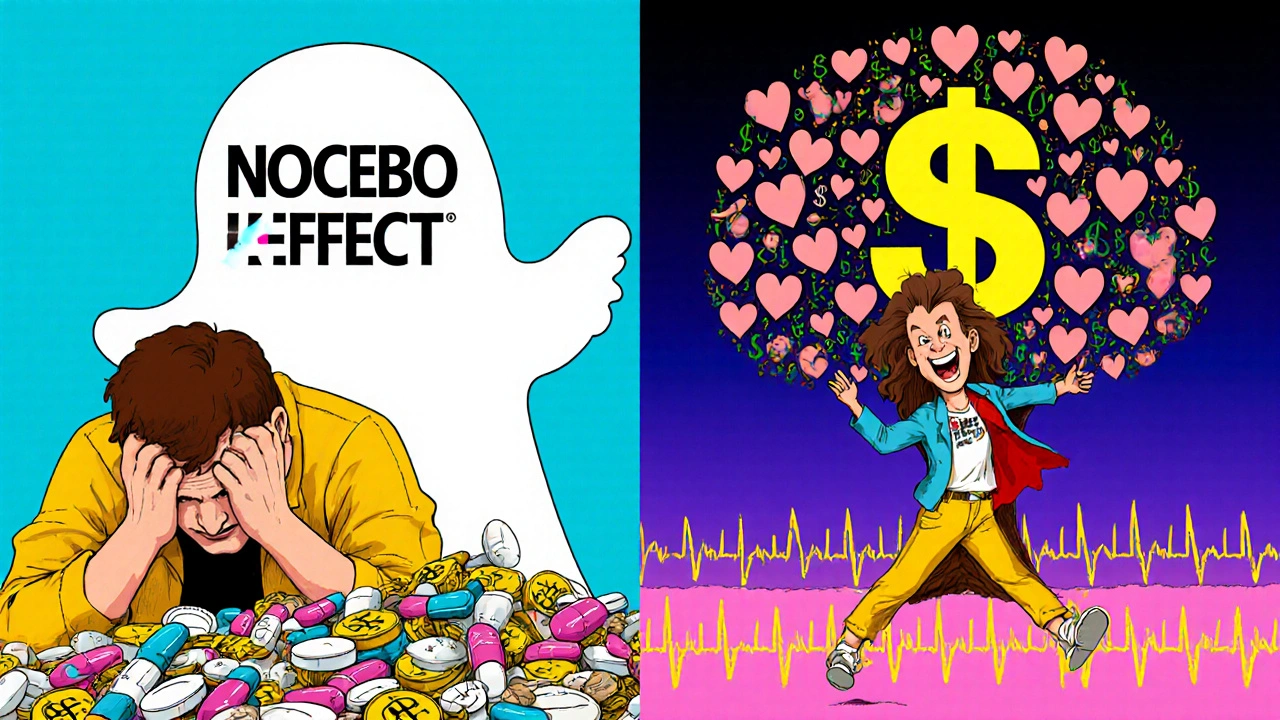Drug Interactions: Are Generic and Brand Medications Equally Risky?

When you pick up a prescription, you might see two options: the familiar brand-name pill or a cheaper generic version. Many people wonder - is one safer than the other when it comes to drug interactions? The short answer: no, the risk isn’t higher with generics. But the full picture is more detailed than most people realize.
Why the confusion exists
It’s easy to assume that because generics cost less, they must be less reliable. But that’s not how the system works. The U.S. Food and Drug Administration (FDA) requires that generic drugs contain the exact same active ingredient, in the same strength, and delivered the same way as the brand-name version. That means if you’re taking a generic version of lisinopril, you’re getting the same molecule that lowers blood pressure as the brand-name Zestril. The real difference lies in the inactive ingredients - things like fillers, dyes, or preservatives. These don’t affect how the drug works in your body, but they can cause rare side effects. For example, someone with a lactose intolerance might get stomach upset from a generic version that uses lactose as a binder, while the brand version uses cornstarch. That’s not a drug interaction - it’s a reaction to an ingredient. But it’s easy to mistake for a problem with the drug itself.How bioequivalence works
Before a generic drug hits the shelf, it must pass a strict test called bioequivalence. This means researchers measure how quickly and how much of the active ingredient enters your bloodstream compared to the brand-name drug. The FDA requires that the generic delivers between 80% and 125% of the brand’s levels. That sounds like a wide range, but in practice, most generics fall within 5% of the brand’s performance. This range exists because human bodies vary. Two people taking the same brand-name drug can absorb it differently due to metabolism, diet, or gut health. So the 80-125% window accounts for natural biological differences - not manufacturing flaws. For drugs with a narrow therapeutic index - like warfarin, levothyroxine, or cyclosporine - the rules are tighter. The FDA requires a 90-111% range for these. That’s because even small changes in blood levels can lead to serious problems: too little warfarin might cause a clot; too much might cause bleeding.Do generics cause more drug interactions?
No. Drug interactions happen because of the active ingredient, not the brand or the filler. If a drug interacts with grapefruit juice, it doesn’t matter if it’s generic or brand - the interaction is the same. Same with alcohol, antidepressants, or supplements like St. John’s wort. A 2020 study in Scientific Reports looked at 17 cardiovascular drugs and found that patients taking generics actually had fewer major heart events and lower death rates than those on brand-name versions. After adjusting for patient factors, the risk of heart attack or stroke was 11% lower with generics. That’s not because generics are stronger - it’s because more people stick with them. They’re cheaper, so patients are more likely to take them as prescribed. Even the FDA’s own adverse event database shows no meaningful difference. From 2015 to 2020, 0.78% of brand-name drug reports mentioned drug interactions. For generics, it was 0.82%. That tiny difference isn’t statistically significant. In other words, it’s noise, not a pattern.
What about those Reddit stories?
You’ve probably seen posts like: “I switched to generic metoprolol and started feeling dizzy with my blood pressure med.” Or “Generic omeprazole made my acid reflux worse.” These stories are real to the people who wrote them. But they’re often misleading. A 2022 Consumer Reports survey found that 18% of people believed generics had different interaction risks - but only 4% had actually experienced a change after switching. That gap suggests something else is going on: the nocebo effect. If you expect a cheaper pill to be worse, your brain might interpret normal side effects as something new or dangerous. Also, when a new generic enters the market, complaints spike for the first few months. Then they drop back to normal. Why? Because pharmacies switch suppliers. You might get a different generic version every time you refill - even if you didn’t ask for it. One version might have a slightly different coating or filler. Your body adjusts over time, but the first switch can feel like a problem.When you should be cautious
There are two situations where switching between generics - or between brand and generic - needs extra care. First, for narrow therapeutic index drugs. If you’re on warfarin, thyroid hormone, or seizure meds like phenytoin, your doctor may recommend sticking with the same version - brand or generic - to avoid small fluctuations. That doesn’t mean generics are unsafe. It just means consistency matters more for these drugs. Second, if you have allergies or sensitivities. Some generics use ingredients like lactose, gluten, or artificial colors that others don’t. If you’ve had a reaction before, check the inactive ingredients. The FDA’s Orange Book lists these for every approved drug. Your pharmacist can help you find a version that matches your needs.
What your pharmacist knows that you don’t
Pharmacists are trained to spot potential issues when a generic is substituted. At major hospitals like UCSF, they check two things: the active ingredient (always the same) and the inactive ingredients (sometimes different). If a patient reports new side effects after a switch, they’ll look at the pill’s manufacturer and formulation. They also know which generics are most likely to cause problems. For example, some generic versions of levothyroxine have been linked to slight absorption changes due to differences in crystal structure. That’s why many endocrinologists prefer one specific brand or generic for thyroid patients - not because generics are unsafe, but because consistency helps stabilize dosing.Global standards and future trends
The U.S. isn’t alone. The European Medicines Agency uses a tighter bioequivalence range (90-111%) for all drugs, not just narrow ones. That’s why some people in Europe report fewer switching issues. The FDA is now investing $24 million through 2026 to study whether different generic versions of the same drug might interact differently in real-world use. They’re using advanced lab tests and real patient data to find any hidden patterns. So far, nothing has shown a consistent safety problem. By 2028, most drugs will have multiple generic makers. That’s good for prices, but it means more variation in fillers and coatings. The key will be tracking which formulations work best for which patients - not assuming one is better than another.What you should do
If you’re taking a generic drug and feel fine - keep taking it. There’s no reason to switch unless your doctor recommends it. If you’ve had a bad experience after switching, don’t assume it’s the generic’s fault. Talk to your pharmacist. Ask: “Is this the same formulation I took before?” and “Can you check the inactive ingredients?” For high-risk medications, ask your doctor if they recommend staying on one version. Write it down: “Dispense as written” on the prescription. That tells the pharmacy not to substitute. And remember: the biggest risk isn’t the generic. It’s skipping your meds because they cost too much. Generics save the U.S. healthcare system over $1.6 trillion a decade. They’re not just affordable - they’re life-saving.Are generic drugs less effective than brand-name drugs?
No. Generic drugs must meet the same FDA standards for effectiveness as brand-name drugs. They contain the same active ingredient, in the same strength, and work the same way in your body. Studies show they perform equally well - and in some cases, patients do better on generics because they’re more affordable and easier to take consistently.
Can generic drugs cause different side effects than brand-name drugs?
The side effects from the active ingredient are the same. But rare reactions can happen because of different inactive ingredients - like dyes, fillers, or preservatives. For example, someone allergic to a dye in one generic version might react, while another version without that dye doesn’t cause issues. These aren’t drug interactions - they’re ingredient sensitivities.
Do drug interactions change when I switch from brand to generic?
No. Drug interactions depend on the active ingredient, not whether the drug is generic or brand. If grapefruit juice affects your blood pressure pill, it will affect the generic version the same way. The FDA and major medical groups agree: bioequivalent drugs have the same interaction potential.
Why do some people say their generic medication doesn’t work as well?
Sometimes it’s the nocebo effect - expecting a cheaper drug to be weaker makes people notice normal side effects more. Other times, they switched between different generic versions, each with slightly different fillers. That can cause temporary adjustments in how the drug feels, even if the active ingredient is unchanged. Most people adjust within a few weeks.
Should I always ask for the brand-name drug if I have a serious condition?
Not unless your doctor recommends it. For most drugs, generics are just as safe and effective. But for narrow therapeutic index drugs - like warfarin, thyroid meds, or epilepsy drugs - staying on the same formulation (brand or generic) helps avoid small changes in blood levels. Ask your doctor if your medication falls into that category.
How can I find out what’s in my generic drug?
Ask your pharmacist for the manufacturer and lot number. Then check the FDA’s Orange Book online - it lists all approved generics and their inactive ingredients. If you have allergies or sensitivities (like to lactose or gluten), this helps you avoid versions with problematic fillers.
Katy Bell
November 22, 2025 AT 16:49So I switched my generic lisinopril last month and thought I was having weird side effects-until I realized I’d also started drinking more grapefruit juice. Turns out, it wasn’t the pill. It was me. Thanks for clarifying that the interaction stays the same no matter the brand.
Ragini Sharma
November 23, 2025 AT 05:34generic omeprazole made me feel like my stomach was full of angry wasps lmao but then i switched back and it was the same?? so i think my brain just hates cheap pills??
Manjistha Roy
November 23, 2025 AT 20:38As someone who’s been on levothyroxine for 12 years, I’ve switched between three different generics-and each time, my TSH bounced around like a ping pong ball. My endocrinologist finally said: ‘Pick one and stick with it.’ It’s not about safety-it’s about consistency. Don’t let the pharmacy play roulette with your hormones.
Jennifer Skolney
November 24, 2025 AT 00:56My grandma takes 12 meds. She switched to generics to save money-and now she’s actually taking them all on time. That’s the real win. Price shouldn’t be a barrier to health. 💪
JD Mette
November 24, 2025 AT 10:08I’ve had patients report ‘generic didn’t work’-but when we checked the bottle, they’d been taking it at night instead of morning. Or they skipped doses when they felt fine. The drug wasn’t the issue. The behavior was.
Ross Ruprecht
November 24, 2025 AT 12:26Why are we even talking about this? It’s just a pill. If you’re overthinking your meds, maybe you should stop Googling and start living.
Suresh Ramaiyan
November 26, 2025 AT 10:12It’s funny how we treat medicine like it’s magic-when it’s really just chemistry. The active ingredient doesn’t care if it’s branded or generic. What matters is whether you take it. And if a cheaper version means someone doesn’t skip doses because they can’t afford it? That’s not just smart-it’s humane.
I’ve seen people in rural India choose between food and meds. Generics aren’t a compromise-they’re a lifeline. The fear around them is often cultural, not clinical.
Yes, fillers vary. Yes, some people react. But those are edge cases. The system works. The FDA isn’t perfect, but it’s not corrupt either.
When someone says ‘my generic made me sick,’ I ask: ‘Did you change anything else?’ Diet? Sleep? Stress? Time of day? Often, the answer is yes-and the pill is just the scapegoat.
And yes, the nocebo effect is real. Your brain can convince you that a blue pill is weaker than a white one-even if they’re identical.
But we shouldn’t dismiss real experiences either. If someone’s TSH spikes after a switch, we listen. Not because generics are dangerous, but because biology is messy.
Consistency matters more than cost. But cost matters more than pride.
So if your doctor says ‘stick with one version,’ do it. If they say ‘switch to generic,’ trust them. And if you’re worried? Ask your pharmacist for the Orange Book entry. Knowledge is power.
Medicine should be accessible. Not perfect. Not fancy. Just available.
Generics aren’t the problem. The system that makes people choose between pills and rent? That’s the problem.
Henrik Stacke
November 26, 2025 AT 14:01Having lived in both the UK and the US, I can confirm: the EMA’s tighter bioequivalence standards do reduce switching-related complaints. In the UK, pharmacists are required to inform patients when a generic substitution occurs. Here? You get a different pill and assume you’re going mad. A little transparency goes a long way.
Also, the term ‘bioequivalent’ is misleading to the public. It sounds like ‘almost the same.’ But in reality, it means ‘statistically indistinguishable in absorption.’ We need better public education, not just better science.
Linda Rosie
November 27, 2025 AT 11:37Consistency over substitution. Always.
Vivian C Martinez
November 29, 2025 AT 10:27I’ve worked in pharmacy for 18 years. The biggest threat to patient health isn’t generic drugs-it’s the myth that they’re inferior. That myth costs lives. People stop taking meds because they think the generic won’t work. We need to fight that narrative every day.
Olanrewaju Jeph
November 30, 2025 AT 14:03In Nigeria, generics are the only option for most people. We don’t have luxury brands. We have survival. And yet, our outcomes for hypertension and HIV are comparable to Western countries-because the active ingredients work. Science doesn’t care about your country’s GDP.
Dalton Adams
December 2, 2025 AT 03:47Let’s be real-most people don’t know what ‘bioequivalence’ means. And honestly? Most doctors don’t either. I’ve seen prescriptions written for ‘generic lisinopril’ with no manufacturer specified-and then the pharmacy rotates suppliers every refill. That’s not healthcare. That’s pharmaceutical roulette. The FDA should mandate manufacturer consistency for all high-risk drugs. Period. And if you’re an endocrinologist who doesn’t insist on that? You’re doing your patients a disservice.
Also, the fact that the FDA is spending $24 million to study this? That’s a joke. They should’ve done this 20 years ago. Now we’re playing catch-up while people suffer unnecessary side effects from inconsistent fillers. It’s not ‘noise’-it’s negligence.
And don’t even get me started on how pharmacies profit from switching. They get paid more when they substitute. That’s a conflict of interest disguised as cost-saving. 🤦♂️
Kane Ren
December 2, 2025 AT 04:51Generics saved my life. I was on $400/month brand-name meds. Switched to generic-$12. Now I can afford my insulin too. Don’t let fear stop you from taking what you need. You’re not weak for choosing affordable. You’re smart.